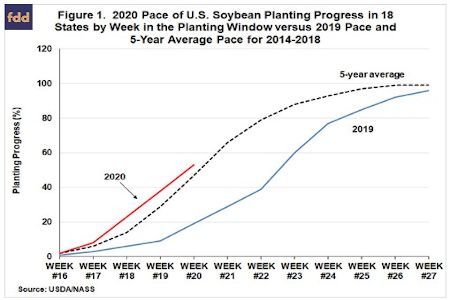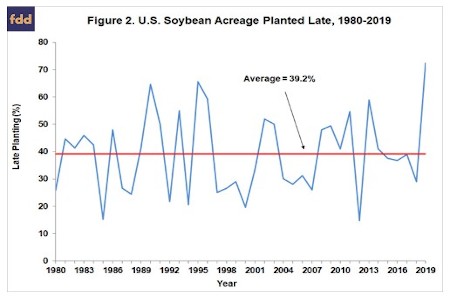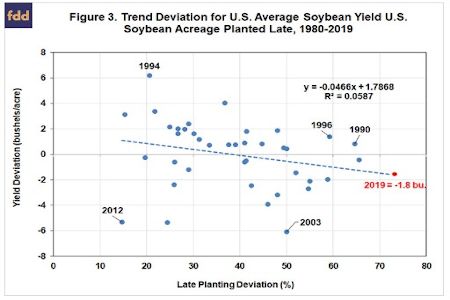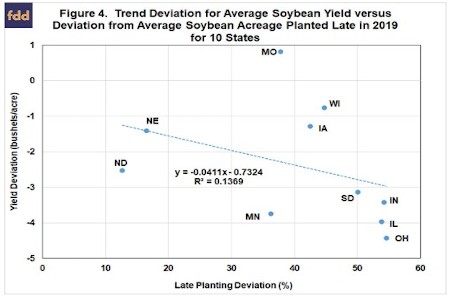By Todd Hubbs and Scott Irwin
Department of Agricultural and Consumer Economics
University of Illinois
Based on recent weekly Crop Progress reports from the USDA, planting progress for the 2020 U.S. soybean crop has been proceeding at a faster than normal pace. Figure 1 shows that 53 percent of soybean acreage in 18 major producing states was planted as of May 18, 2020 (week #20), six percentage point higher that the 5-year average for this week. By comparison, only 19 percent of the crop in 2019 was planted as of this date due to exceptionally wet conditions (farmdoc daily, May 9, 2019; June 6, 2019). The extreme lateness of planting the 2019 soybean crop represents a valuable data point to help estimate the impact of late planting on soybean yields. The purpose of this article is estimate the impact of late planting on the U.S. average soybean yield over 1980-2019 using three different approaches and compare the estimates for consistency. We also discuss implications for projecting the U.S. average soybean yield in 2020. The analysis is similar to that in our article last week on late planting and the U.S. average corn yield (farmdoc daily, May 13, 2020).

Analysis
We begin the analysis by considering the beginning date for a significant late planting penalty for soybean yields. There is not complete agreement on the optimum planting window for maximizing soybean yields or the date when late planting begins to impose a substantial yield penalty. Both the optimum window and cutoff date for a significant late planting penalty certainly varies by geographic location. For market analysis purposes, however, it is useful to identify one date for the end of the optimum window that can be applied to the U.S. soybean crop. Acreage planted after that date would be considered to be planted late and yield potential would be expected to be reduced as the percentage of the acreage planted late increases.
In order to set the late planting cutoff date in our earlier work (farmdoc daily, May 2, 2018; June 6, 2019), we reviewed information generated from agronomic research relating planting date to soybean yields at the farm-level. For example, field trial data provided by Professor Emerson Nafziger indicates that soybean yield loss in Illinois is minimized (optimal planting window) by planting in mid- to late-April, the same as for corn. The yield penalties become increasingly large as planting is delayed after mid-May, with planting on or after May 30 resulting in a soybean yield loss of 15.8 percent, or 11 bushels per acre.
Results from soybean planting date research for different years and different locations vary throughout the U.S., but the evidence indicates planting on or before May 1 generally is associated with higher yield. De Bruin and Pederson (2008) provide widely-cited evidence in this regard for Iowa and also highlight earlier studies from the 1980s and 1990s that showed the benefits of earlier planting of soybeans in the upper Midwest of the U.S. Early planting benefits are not limited to the Midwest. A veritable revolution has occurred in the Mid-South and Delta regions in the last 25 years regarding soybean planting dates. For example, Orlowski and Irby (2017) show that the optimum window for planting irrigated soybeans in Mississippi is centered on late April to early May. In all cases for the Midwest and the South, yield penalties rise rapidly for planting dates after mid- to late May.
We previously defined the beginning date for substantial late planting penalties on soybean yield in the U.S. to be June 5 from 1980-1985, May 30 from 1986-1999 and May 25 from 2000 forward (farmdoc daily, May 2, 2018; June 6, 2019). One can certainly argue for an earlier cutoff date in later years, e.g., May 10, in the heart of the Corn Belt based on planting date studies. However, we opt for the May 25 date in light of the large shift in soybean acreage in the far northern parts of the Corn Belt and the later date of the optimal planting windows in these areas. This also keeps the cutoff date for soybean late planting after the cutoff date for corn (May 20), consistent with the behavior of U.S. farmers in planting the two crops.
Figure 2 shows the percentage of soybeans planted late in the U.S. over 1980-2019 based on the cutoff dates specified above. On average, late planting based on this measure was 39.2 percent, with the bulk of the observations between about 20 and 50 percent. There is no evidence of a trend up or down over time in the late planting percentage using our cutoff dates, which results in a stable measure of late planting. The average level of late planting for soybeans, 39.2 percent, is much higher than for corn, 17.7 percent, that we reported in the farmdoc daily article of May 13, 2020. At least half of this difference can be attributed to double-crop planting of soybeans. Late-planted soybean acreage in 2019 came in at the highest total since 1980 with 72 percent remaining to be planted as of May 25. While 2019 was the highest in the sample period, that late planting was almost as high in two previous years (1990 and 1995).

The next step of the analysis is to estimate the impact of late planting on the U.S. average soybean yield. The first method we use is to directly estimate the relationship between the trend deviation for U.S. soybean yield and U.S. soybean acreage planted late over 1980 through 2019. The trend deviation is computed based on a quadratic trend for U.S. average soybean yields over this period. Figure 3 shows that, as expected, there is an overall negative relationship between late planting and soybean yield deviations from trend. Specifically, for a 10 percent increase in late planting the U.S. average soybean yield decreases by 0.5 bushels per acre. It is also interesting to consider the implication of the intercept estimate of the regression model. It implies that when late planting is zero the increase in soybean yield above trend is 1.8 bushels. This is the maximum benefit of early planting on the U.S. average yield of soybeans according to this regression model. It the same magnitude as the yield penalty for late planting in 2019, the largest during the sample period.

It is important to emphasize that the explanatory power of the regression model in Figure 3 is quite low, as the R2 is only 5.9 percent. Because of this low explanatory power, the regression model in Figure 3 should be treated with a good deal of caution. This does not mean that late planting should be ignored when projecting soybean yield, but rather, other factors, in particular summer weather, are typically more important in explaining deviations from trend yield. Two years provide good examples. Late planting was well above average in 1996 but the soybean yield was still above trend due to favorable summer weather conditions. Conversely, late planting in 2012 was at the low end of the sample range but the soybean yield was extremely low relative to trend due to the severe drought that summer.
Since a number of factors influence the magnitude of the U.S. average soybean yield in any given year, particularly summer weather conditions, it is necessary to estimate the impact of all relevant factors in order to quantify the impact of late planting. In technical terms, this means that the regression model in Figure 3 may suffer from “omitted variable bias.” We address this problem by estimating a crop weather regression model that relates the U.S. average soybean yield to trend, the percentage of the crop planted late, and an array of weather variables. In brief, based on observations from 1980 through 2019, we specified a crop weather model of the U.S. average soybean yield with a quadratic trend, late planting as shown in Figure 2, quadratic functions of preseason (September-March), April, June, July, and August precipitation, and linear functions of April, May, June, July, and August temperatures as explanatory variables. The weather variables are acreage weighted-averages for the Corn Belt. The model has a high explanatory power, with an R2 of 97.4 percent. The coefficient estimates indicate that the U.S. average soybean yield drops by 0.7 bushels per acre for each 10 percent of the crop that is planted late. It is interesting to observe how close the late planting coefficient estimated for the crop weather model is to estimate from the simple bivariate model presented in Figure 3. The degree of bias in the coefficient from the simple bivariate model appears to be quite small.
Our third and final method of estimating late planting impacts takes advantage of the variation in late planting across Corn Belt states during 2019. The idea is that the variation in late planting and yields across states in 2019 is large enough that it can be used to estimate late planting impacts. It is important that the states included in the analysis are large producing states so the resulting estimate is representative of late planting impacts nationally. With that as background, Figure 4 shows the deviation from soybean trend yield in 2019 for 10 major Corn Belt states versus the deviation from average for late planting in each state. The trend yield for each state is estimated via a quadratic regression over 1980-2019. The deviation from average late planting over 1980-2019 is used instead of the level of late planting because the average level of late planting differs across states. Note also that state level late planting variables are used in this analysis not the national level variable used in the previous two methods.

Figure 4 shows that despite the small number of cross-sectional observations, the regression model has a higher R2 than the bivariate time-series model in Figure 2. The estimated coefficient on the late planting variable is -0.04, which implies that a 10 percent increase in late planting decreases state average soybean yield by 0.4 bushels per acre. This is smaller but close to the estimates for the U.S. average soybean yield generated by the first two methods.
Despite the differences in the three methods and data, the estimates of the impact of late planting on the U.S. average soybean yield are quite similar, ranging between 0.4 and 0.7 bushels per acre for a 10 percent increase in late planting. A median estimate is therefore about 0.5 bushels per acre for a 10 percent increase in late planting. In terms of practical application, it is probably most straightforward to apply this estimate using the deviation from trend for yield and deviation from the average level of late planting. For example, assume a soybean trend yield of 50 bushels per acre for the U.S. in 2020. Next, assume that the trend yield of 50 bushels incorporates the average level of late planting during the 1980-2019 sample period of 39.2 percent. Then, the trend yield can be adjusted upwards or downwards depending on the deviation of 2020 late planting from average. If late planting is 49.2 percent, or 10 percent above average, then trend yield should be reduced 0.5 bushels to 49.5 bushels per acre. Likewise, if late planting is 28.2 percent, or 10 percent below average, then trend yield should be increased 0.5 bushels to 50.5 bushels per acre.
Finally it is interesting to note the consistency between the estimates of late planting impacts on U.S. soybean yield with those reported for corn in our farmdoc daily article of May 13, 2020. We found that the U.S. average corn yield dropped about 2 bushels per acre for a 10 percent increase in late planting. This compares to about a 0.5 bushel per acre drop in the U.S. average soybean yield for a 10 percent increase in late planting. Since the U.S. average soybean yield tends to be about 3.5 times the U.S. average corn yield, we would expect the late planting coefficient for corn to be about 3.5 times the late planting coefficient for soybeans. In other words, starting with a soybean late planting coefficient of 0.5 we would expect a corn coefficient of 0.5 X 3.5 = 1.75. This is close to the median estimate of 2 noted above for the U.S. average corn yield. The implication is that the impact of late planting on U.S. average corn and soybean yield is similar after taking into account the differing level of yield for the two crops.
Implications
The impact of late planting on projections of the U.S. average soybean yield is always widely discussed at this time of year. In this article, we estimate the impact of late planting on the U.S. average soybean yield over 1980 through 2019 using three different approaches and compare the estimates for consistency. The three methods are: i) a bivariate model of U.S. soybean trend yield deviations and the level of late planting, ii) a crop weather regression model that relates the U.S. average soybean yield to trend, the percentage of the crop planted late, and an array of weather variables, and iii) a cross-sectional model of 2019 state soybean yield trend deviations and deviations from average late planting. Despite the differences in the three methods and data, the estimates of the impact of late planting on the U.S. average soybean yield are similar, ranging between 0.4 and 0.7 bushels per acre for a 10 percent increase in late planting. A median estimate is therefore about 0.5 bushels per acre for a 10 percent increase in late planting. Based on weather conditions at the present time, it appears that U.S. soybean acreage planted late (after May 25th) will be near average. Hence, there does not appear to be much reason right now to adjust U.S. average soybean yield forecasts for 2020 above or below trend. This will likely change as we observe summer weather conditions.
Source : illinois.edu